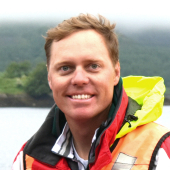
AquaWhere? The science of siting aquaculture for sustainable industry growth
James A. Morris, Jr., Marine Ecologist, NOAA National Ocean Service, USA

James A. Morris, Jr., Marine Ecologist, NOAA National Ocean Service, USA
About the speaker:
James Morris is a marine ecologist at the National Oceanic and Atmospheric Administration (NOAA) National Centers for Coastal Ocean Science (NCCOS) where his research focuses on coastal marine ecology and marine spatial planning. He has led many multidisciplinary research projects and developed programs addressing coastal management challenges including invasive species, fisheries management, stock enhancement, coastal aquaculture development, and endangered species conservation. James is presently leading regional marine spatial planning studies to inform optimal siting of pioneering ocean industries, such as aquaculture and wind energy. James is also an adjunct Assistant Professor at Duke University.
Company info:
The NOAA NCCOS delivers ecosystem science solutions to sustain thriving coastal communities and economies. They provide coastal managers the information and tools they need to balance society's environmental, social, and economic goals (NCCOS URL: https://coastalscience.noaa.gov/).
Presentation:
Finding the right space for offshore aquaculture is challenging given the large number of existing ocean uses and sensitive natural resources. To inform planning and siting of ocean aquaculture, NOAA has developed spatial planning approaches including smart siting applications, spatial suitability models, an array of tools such as the whale entanglement simulator. This increased ocean intelligence has vastly improved access and understanding of ocean regions enabling industry and coastal managers to identify conflicts and opportunities early in the planning and permitting process.
Interview:
1) What is your favorite seaweed and why?
My favorite seaweed would be kelp. Its significance lies in its versatility and ecological importance. Kelp serves as a critical habitat for various marine organisms while offering substantial nutritional value. Moreover, it holds promise for applications beyond its nutritional benefits, including biofuel production and carbon sequestration. Its multifaceted nature makes it a standout in the world of seaweeds.
2) What are the 3 main technological challenges to come to a mature US seaweed industry?
The three primary technological challenges facing the maturation of the US seaweed industry are scalable cultivation methods that minimize environmental impact, optimized harvesting and processing techniques to enhance efficiency and reduce costs, and the establishment of robust infrastructure such as supply chains and processing facilities. Additionally, spatial planning plays a crucial role in addressing these challenges by identifying suitable areas for siting aquaculture operations. Effective spatial planning ensures that aquaculture activities are located in areas with favorable environmental conditions while minimizing conflicts with other ocean uses and maximizing the industry's sustainability and resilience. Addressing these challenges comprehensively is essential for the sustainable growth and widespread adoption of seaweed cultivation in the United States.
3) How does NOAA look at the (future) role of seaweeds in our society?
When it comes to the future role of seaweeds in our society, NOAA is taking a holistic approach. We see seaweeds not just as a potential source of food and fuel, but as integral players in ecosystem health and climate resilience. From carbon sequestration to nutrient cycling, seaweeds offer a range of ecosystem services that are increasingly valuable in the face of climate change. By supporting research and innovation in seaweed cultivation, NOAA is working to unlock the full potential of how seaweed can benefit both people and the planet.